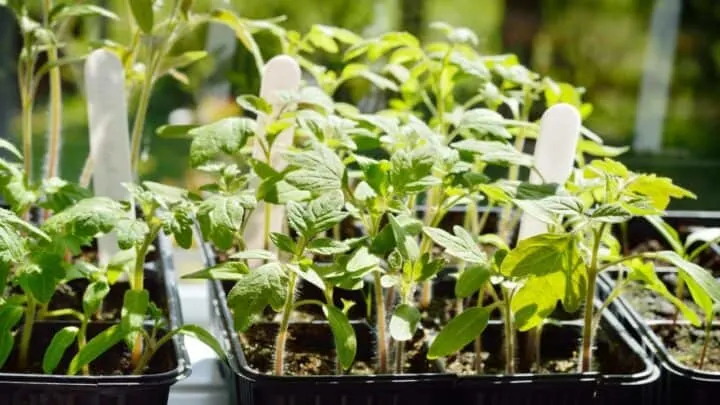Growing your own vegetables and fruits can be such a fun activity to do.
But what if you’re struggling to get your baby tomato plants to thrive?
Perhaps they started off well but are now failing or maybe they never even got going.
So, what’s the culprit of tomato seedlings dying?
Table of Contents
Why are my tomato seedlings dying?
Tomato seedlings start to die due to 6 main reasons. Usually, overwatering and underwatering them are the main culprits. But, sometimes, fungal and bacterial infections, as well as transplant shock, lack of exposure to light, and low temperatures can cause this problem as well.
1. Overwatering
Whilst tomato plants do need frequent watering, perhaps the most common reason that your little tomato seedlings will show signs of distress is overwatering.
Especially at the very early stages – between planting and the first shoots – there is a risk of the seeds “drowning”.
As shoots begin to emerge and the roots begin to establish themselves, overwatering can pose a real danger to the plant.
Oversaturated roots will not be able to absorb water or nutrients from the soil and can be at risk of contracting fungal infections.
Signs of overwatering include your tomato seedling showing a discoloration of the leaves or perhaps even toppling over altogether.
Proper Way of Watering a Tomato Seedling
Tomato plants do need a good amount of water – but seedlings less so. There is a fine line between giving them sufficient moisture and saturation.
Make sure the top layer of soil – about an inch – has dried out before watering. And certainly, if you see water pooling in the soil on the surface you definitely should not water!
In the very early stages, it may be better to mist the plants morning and night instead of directly watering the soil.
2. Underwatering
Of course, things can go both ways. Especially if you keep your tomato seedlings in containers, underwatering can be just as dangerous.
The soil in a container can heat up quickly and evaporate water fast.
Watering in the morning should ensure your plants get what they need, but pay attention to the moisture content of the soil per the guidance above.
3. Sudden Changes in the Environment
Another common concern is a sudden change in your tomato seedlings’ environment.
This commonly happens when transplanting store-bought seedlings into new soil.
Try to mix in the original soil with the new potting mix and if you suspect transplant shock may be an issue, you can add a phosphorous mix to help the seedlings establish.
4. Early Disease
Another reason your tomato seedlings may be dying could be disease.
Often referred to as blight, this is common in the early stages – especially if it is particularly humid – and appears as black marks on the stem and leaves.
Fungal infections too – including those caused by Pythium – create a condition commonly known as “damping off”.
This phenomenon usually occurs in very damp environments. Here, the seedlings will begin to droop, eventually wilting and dying.
Preventing Diseases and Fungal Infections in your Tomato Seedlings
Try to control the humidity levels if possible, and water only into the soil – not onto the top of the plant.
You may also want to purchase a fungicide to use lightly in order to avoid any infections.
Make sure any fungicide you buy is specifically designed for tomato plants.
The US Department of Agriculture publishes further advice on how to control infection on their website.
5. Bacterial Infections
Bacterial infections too can quickly destroy your crop.
Often these are introduced through a small blemish or “nick” in your tomato plants or can be caused by environmental factors.
Leaf Spot’s the most common bacterial infection affecting your tomato seedlings, appearing as yellow marks on the leaves.
It can be caused by fluctuations in temperatures between hot and cold.
The tricky part about managing bacterial infections is that they may be already present from the seed.
Try to avoid purchasing off the internet and go instead to a trusted local supplier.
6. Lack of Light or Warmth
If your seedlings are not getting the light they require, they will fail to thrive.
Once they break through the surface you need to make sure they are exposed to light and warmth.
Likewise, you will likely know not to expose the new seedlings to frost or temperatures below what the particular variety can tolerate.
Some can handle temperatures down to 55 degrees Fahrenheit.
Frequently Asked Questions about Why My Tomato Seedlings are Dying
What are these marks on the leaves of my tomato seedlings?
Dark or yellow patches on your tomato seedlings can mean several things. Usually, fungal or bacterial infections can cause discoloration. Overwatering too can cause yellowing of the leaves, as can incorrect light.
How can I stop infections on my tomato seedlings?
Avoid watering your seedling from overhead, instead spray mist into the soil. This reduces the risk of any fungal infections caused by a damp environment. Make sure to get your seeds also from a reputable seller – some bacterial infections can actually already be present in the seeds even before they germinate! Oh, and keep bugs away.
Conclusion
Once you have worked out how to get your seedlings to thrive, you will need to read up on the next phase of tomato plant care, including pruning, fertilizing, and cloning your plants.

Daniel has been a plant enthusiast for over 20 years. He owns hundreds of houseplants and prepares for the chili growing seasons yearly with great anticipation. His favorite plants are plant species in the Araceae family, such as Monstera, Philodendron, and Anthurium. He also loves gardening and is growing hot peppers, tomatoes, and many more vegetables.


